The Call of the Mountains: The crash of Iran Aseman Airlines flight 3704
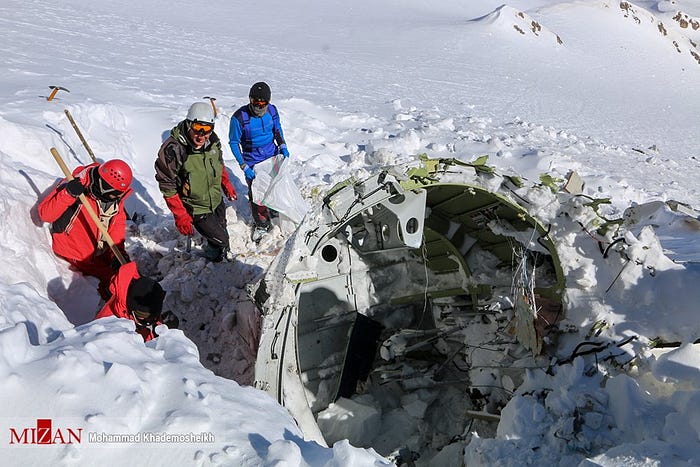
On the 18th of February 2018, an Iranian airliner disappeared on approach to the ancient city of Yasuj, taking with it the lives of 66 passengers and crew. Two days later, search teams found the wreckage of the ATR-72 smeared across the face of Mount Dena at an elevation of 4,000 meters, surrounded by a moonscape of rock and blowing snow. There were no survivors.
Much of the early speculation centered on a common problem in Iranian aviation: the lack of spare parts caused by Western sanctions. Others speculated that the crash was caused by ice on the wings, or that the pilots simply descended too low and flew into the mountain. But as investigators painstakingly examined the contents of the badly damaged black boxes, they discovered that the cause was something else entirely. As they descended into a notorious airport amid bad weather, searching for a break in the clouds, the pilots unwittingly flew into a deadly and invisible force that literally dragged their plane out of the sky and dashed it against the jagged mountaintop, despite their confused and frantic efforts to fight it. The unsettling story of Iran Aseman Airlines flight 3704 would thus underscore not only the enduring power of nature, but also the consequences of failing to properly evaluate the risk that it still poses.

If you wanted to find the hardest place to run an airline, it would be difficult to top the Islamic Republic of Iran. Ever since the Revolution of 1979, the country’s aviation industry has been all but severed from the global system. Sanctions against the Iranian government make it extremely difficult to import airplanes and spare parts, forcing airlines to keep old planes in operation far beyond their expected service lives. Iran’s passenger fleet is the oldest in the world, and several Western models that had largely been retired decades ago saw service in Iran well into the 2010s. Combined with spotty enforcement and a questionable safety culture, this fact has made Iran one of the most dangerous places to fly.
One of the airlines serving Iran’s domestic market is Iran Aseman Airlines, a nominally private carrier owned by the country’s National Pension Fund. The airline has never been known for its safety. Until 2019 it operated the last Boeing 727 in commercial passenger service anywhere in the world, and after a series of alarming accidents and incidents it was banned from flying to the European Union. But for the residents of one Iranian city, none of this made any difference: their transportation choices, for the most part, were Iran Aseman Airlines or nothing.

In 2018 Iran Aseman Airlines was the only major airline to operate scheduled passenger services into Yasuj, a city of about 135,000 people in southwestern Iran. Situated 1,800 meters (6,000 feet) above sea level in the Zagros Mountains, Yasuj presents a formidable challenge to pilots, who must navigate bad weather and treacherous mountain peaks, including the 4,400-meter (14,400-foot) Mount Dena, an imposing massif which stretches for 80 kilometers to the north of the city. To make matters worse, in 2018 Yasuj Airport had only the most primitive infrastructure: it had no runway lighting system, no instrument landing system, no VOR beacon, and no air traffic control service. The only way to approach Yasuj Airport was to fly to a single, ancient non-directional beacon (NDB), catch sight of the airport, and then circle around to land visually. For this reason, most airlines refused to even consider flying to Yasuj, leaving Iran Aseman Airlines to fill the gap with a daily service to and from Tehran.

As dawn rolled over Iran on the 18th of February 2018, the weather at Yasuj was already taking a turn for the worse. Weather observers noted cumulonimbus clouds at an elevation of 9–10,000 feet (3–4,000 feet above ground level), with a solid overcast layer at around 15,000. The wind at the airport was calm, but higher up, powerful straight-line winds were whipping over the freezing summits of the Dena massif.
Due to the lack of navigational and approach aids, the weather minima for Yasuj Airport were very high: pilots could not even attempt an approach unless the cloud ceiling was at 17,000 feet or higher and there were no thunderstorms. Today, the weather met neither of these conditions. But at Tehran’s Mehrabad International Airport, the pilots of Iran Aseman Airlines flight 3704 nevertheless prepared to depart for Yasuj. Although they knew conditions were unsuitable for landing, they decided to conduct the flight anyway because the weather was good at both of their alternate airports, giving them the option of a safe diversion if the conditions did not improve.
At 8:05 a.m. local time, flight 3704 departed Tehran for the approximately 90-minute flight to Yasuj. In command of the twin turboprop ATR-72 were 62-year-old Captain Hojatollah Foladi, a veteran pilot with over 18,000 flight hours, and 36-year-old First Officer Khevah Khalili, who was relatively new to both the ATR-72 and to flying in general. They were joined by two flight attendants, two in-flight security personnel, and 60 passengers, totaling 66 people on board.
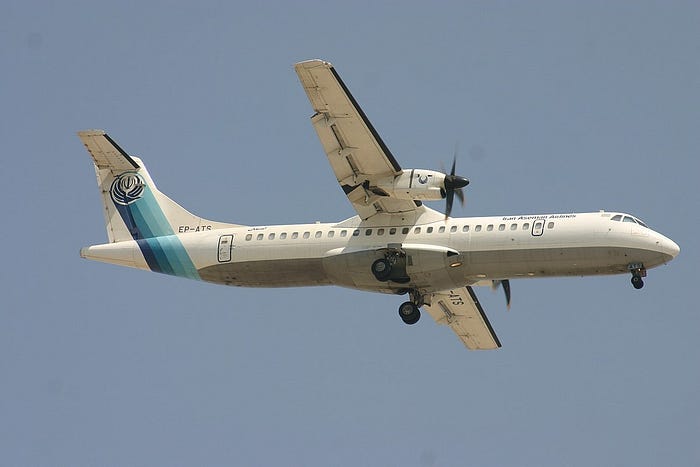
After takeoff, flight 3704 climbed to its cruising altitude of 21,000 feet, continued south past the city of Isfahan, and joined the W144 airway, which leads directly to Yasuj Airport from the northeast.
At 9:19, the crew mentioned their intention to perform an NDB circling approach to runway 31, the only authorized instrument approach at Yasuj Airport. Basically, this procedure requires tracking an imprecise NDB, painstakingly accounting for the wind in order to stay on course, then circling around by hand to land on the desired runway as soon as the airport comes into view. However, pilots around the world dislike NDB approaches, and if they can perform a purely visual approach instead, they will almost always try to do so. In practice, this was what everyone did at Yasuj, because the minimum visibility was so high that pilots could usually catch sight of the runway before they had even bothered to line up with the NDB.
By the time the crew discussed their approach options, the reported overcast layer was still 9,000 feet above the ground, or 15,000 feet above sea level, below the minimum for the NDB approach. But Captain Foladi didn’t seem perturbed: they would just descend to 15,000 feet, he said, and then they would break out of the clouds. If they saw the runway, they could request a visual approach, and then landing would be simple.
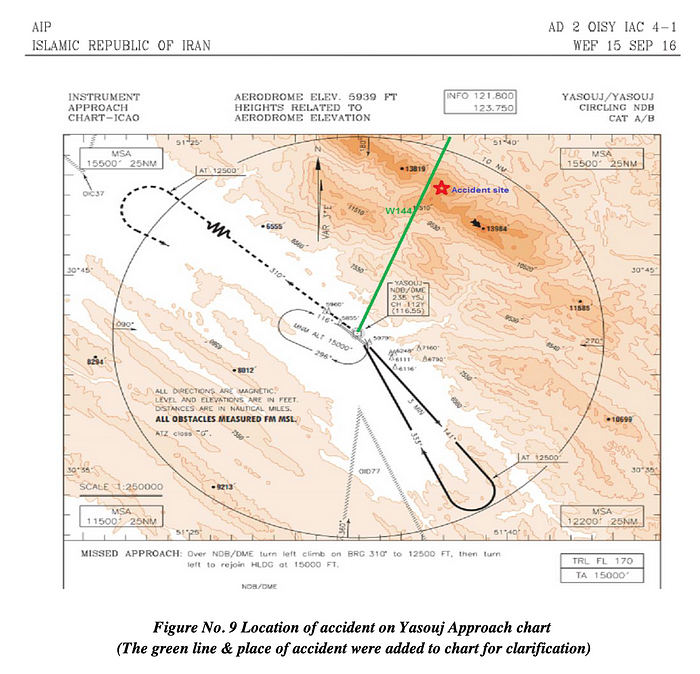
According to their charts, the minimum en route altitude on the W144 airway was 17,000 feet all the way to the Yasuj NDB, precluding a descent below the cloud layer while on the airway. However, the minimum safe altitude (MSA) for the general area to the northeast of the airport was lower, at 15,500 feet. Pilots flying to Yasuj had thus made a habit of leaving the designated airway and entering uncontrolled airspace in order to descend from 17,000 feet to 15,500 feet, break through the clouds, and request visual approaches. This saved time which would otherwise be spent descending in a holding pattern over the airport and allowed them to land in conditions worse than the 17,000-foot minimum cloud ceiling without violating any minimum altitudes. In this case, however, the cloud ceiling was below 15,500 feet, meaning that a descent to this altitude followed by a visual approach would not be possible. Captain Foladi’s intent, therefore, was to fly down to the level of the reported cloud ceiling, which, while 500 feet below the minimum safe altitude, was still above the height of the mountains.

At 9:22, with First Officer Khalili at the controls, Captain Foladi contacted the Tehran area control center and informed the controller that flight 3704 was ready to begin its descent into Yasuj.
“Descend to flight level 170, radar service terminated, continue to destination,” the controller replied.
Thirty seconds later, Foladi contacted the Yasuj Airport Flight Information Service (AFIS) office and informed the officer on duty that they were 35 miles from the airport and descending to 17,000 feet. The AFIS officer, unlike a true controller, was responsible only for providing information to pilots; he did not have the authority to give instructions and did not have radar to track the plane’s position. Instead, he simply acknowledged the pilots’ transmission, then said, “Sir, final for runway 31 is clear; if you make an NDB circling approach, you should be able to see the runway.”
“Inshallah, we will come out of the clouds at 15 or 14,500,” Captain Foladi replied, implying his intention to request a visual approach as soon as possible.

What the pilots didn’t realize was that they had put their plane on a collision course with a meteorological phenomenon called a mountain wave. High mountains sometimes stick up into bands of powerful straight-line winds, wreaking havoc on the airflow and creating a series of high-amplitude standing waves that can trail downwind of the mountain for hundreds of kilometers. The waves are strongest immediately on the lee side of the mountain, where aircraft can encounter vertical winds as strong as 8,000 feet per minute (40 meters per second), as well as small standing rotors strong enough to tear an aircraft apart in flight. Most famously, BOAC flight 911, a Boeing 707, broke up in midair over Japan in 1966 after encountering a rotor associated with the mountain wave on the lee side of Mount Fuji. That having been said, commercial aircraft rarely encounter mountain waves; historically, they have posed a much greater danger to small private aircraft, which fly closer to the mountaintops and have limited ability to escape from powerful downdrafts.
Today, the mountain wave rolling off of Mount Dena was not strong enough to rip a plane apart in midair, but that didn’t mean it wasn’t dangerous. As flight 3704 descended from 17,000 feet, it began to encounter a series of standing waves, alternating between updrafts and downdrafts which grew stronger with every passing minute. But it was only when the crew leveled off at 15,000 feet that the wave began to cause noticeable problems. Struck from below by a powerful updraft, the autopilot was forced to pitch the nose down five degrees simply to prevent the plane from climbing, even with the engines at idle. This unusual configuration didn’t seem to capture the pilots’ attention, but the general situation did: “What bad weather!” First Officer Khalili exclaimed, staring out into the sea of roiling clouds. Evidently the real cloud base was lower than 15,000 feet.

Now the updraft began to transition to a downdraft with a speed in excess of -2,000 feet per minute. In order to prevent the plane from descending under the influence of the downdraft, the autopilot had to increase the angle of attack — the angle of the wings relative to the airflow. This would increase lift, keeping the plane level at 15,000 feet, as the autopilot had been instructed to do.
Consequently, the plane began to fly in a wallowing, nose-high position as it fought against the powerful downdraft. But with such a high angle of attack, drag increased significantly, and more power was needed to maintain the proper airspeed. The pilots advanced the thrust levers to 67% of max power, but this was not enough to correct the problem. The plane began to lose speed, dropping steadily from its target speed range of 180–200 knots.
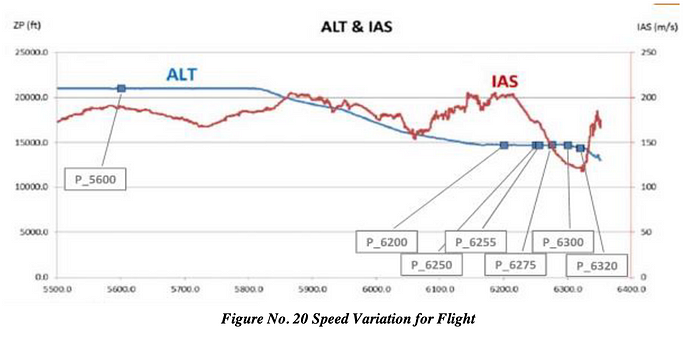
Meanwhile, knowing that the highest point on the ridge under the W144 airway topped out at about 13,500 feet, Captain Foladi decided to descend to 14,000, hoping that this would be enough to break out of the clouds and see the airport.
“Could we descend?” Khalili asked.
“Set it to 140,” Foladi ordered. Khalili entered 14,000 feet into the autopilot, and the plane began to descend. But by now the speed of the airplane had fallen so low that it could barely keep itself airborne, and the downdraft only continued to increase in its intensity, reaching -3,200 feet per minute (-16m/s) as they approached the cloud-shrouded mountaintop. If they let their speed drop any more, the plane could stall and fall out of the sky.
Suddenly, 30 seconds into the descent, the stall warning activated, shaking the pilots’ control columns as alarms blared in the cockpit. The autopilot disconnected with an aural cavalry charge warning, and a system called the stick pusher sprang into action, automatically pitching the nose down from 15 degrees to 2 degrees in an attempt to increase speed and prevent the plane from stalling. As their speed bottomed out at a scarily low 117 knots, Captain Foladi grabbed the control column and pitched down steeply, trying to regain enough speed to get out of danger. Battered by turbulence, the plane rolled 20 degrees to the left, then twelve degrees to the right.
“May I set the flaps?” First Officer Khalili asked. The stall recovery procedure called for them to set the flaps to 15 degrees and apply power as needed. But Foladi didn’t reply, and no one set the flaps.
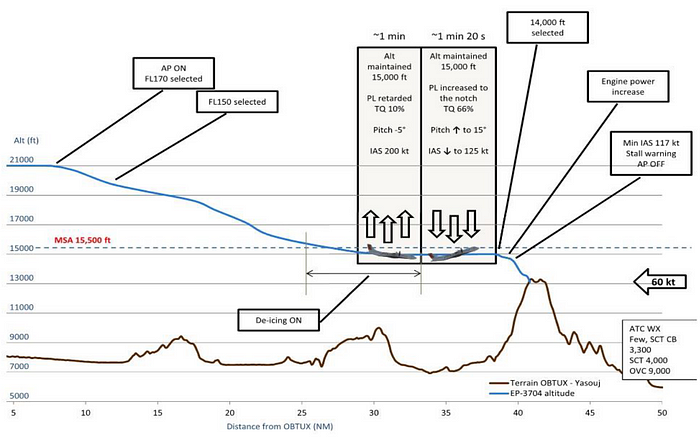
Descending steeply now, their speed increased back to 137 knots, and the stick shaker stopped. Captain Foladi pulled back from -9 degrees nose down to -4, but they were flying on a knife’s edge: pitch up more and they might lose speed and stall again; pitch down and they would surely collide with the mountain. In a state of near-panic, Foladi did the only thing he could think of: he attempted to re-engage the autopilot. “Please set autopilot!” he shouted, and Khalili immediately pressed the autopilot button.
At that point the plane was passing through 14,200 feet at a blistering descent rate in excess of -4,000 feet per minute. Although the autopilot had earlier been set to level the plane at 14,000 feet, and Foladi evidently hoped that it would find some way to do so, this was a physical impossibility. Within seconds the plane shot through 14,000 feet and kept descending, the autopilot unable to arrest the descent and capture the target altitude. Four seconds after Foladi’s command to engage the autopilot, the ground proximity warning system began to blare: “TERRAIN AHEAD! TERRAIN AHEAD! TERRAIN AHEAD! PULL UP! PULL UP!”
Captain Foladi again grabbed the controls, trying desperately to avert a collision with the mountain. The autopilot automatically disengaged for a second time as he hauled back on his yoke. The cockpit filled with a cacophony of alarms and wind noise, like a grim orchestra backing the plane’s final plunge toward the ragged mountaintop.
“TERRAIN! TERRAIN! WHOOP WHOOP, PULL UP! WHOOP WHOOP, PULL UP!”
But they were out of time. At 9:31 and 42 seconds, Iran Aseman Airlines flight 3704 slammed into Mount Dena at an altitude of 4,000 meters (13,000 feet), shattering instantaneously against the snow-covered mountainside. The wreckage surged up the slope for a short distance, then ground to a halt. There was no fire, no smoke, no cry for help — only the eerie howling of the wind amid the flying snow.

◊◊◊
Three minutes later, the AFIS officer tried to call flight 3704 to inquire about its progress, but received no response. In fact, he would never hear from the crew again. Fearing the worst, authorities launched a search and rescue mission, but with high winds and dense clouds still shrouding the summit of Mount Dena, where the plane was believed to have crashed, the chances of finding it that day were slim. A drone was sent to try to survey the area, but it was unable to see anything through the blinding storm.
It was not until the 20th of February, more than 48 hours after the crash, that a reconnaissance plane managed to spot what was left of flight 3704. Half-buried beneath more than a meter of snow, the wreckage of the ATR-72 lay strewn across the bleak and icy summit, barely distinguishable from the jagged rock outcroppings that surrounded it. Only one thing identified it as the remains of an aircraft: the battered tail, in full Iran Aseman Airlines livery, lying forlorn atop the snow.

Later that day, rescuers reached the site, confirming what everyone already knew: none of the 66 passengers and crew had survived. In fact, the crash was so violent that recovery teams found no complete bodies, only body parts.
Due to the harsh conditions at the accident site, investigators with the Aviation Accident Investigation Board of the Civil Aviation Organization of Iran faced a major challenge. Most of the wreckage would have to remain in situ at least until the snow melted in spring, while mountaineers helped them bring down the bodies of the victims and the all-important black boxes. Both had been heavily damaged, and the cockpit voice recorder ultimately had to be sent to a specialized laboratory in France to repair moisture damage and extract the data. In the meantime, the Civil Aviation Organization (CAO) grounded the country’s ATR fleet until the safety of the planes could be assured.

Although media reports on the crash focused on the inability of Iranian airlines to get spare parts due to Western sanctions, investigators quickly ruled out the possibility of a mechanical failure aboard the 25-year-old airplane. The black box data showed no sign of a mechanical problem, but it did reveal two key observations: first, that the pilots deliberately descended below the minimum safe altitude, and second, that something negatively affected the plane’s performance, dragging it down into the path of a mountain that it should have been able to clear.
Initially, the number one culprit was ice. The ATR-72 is known to be particularly vulnerable to ice on the wings, with several fatal crashes attributed to ice buildup, either on the ground or in flight. But there was a problem with this theory too: at the altitude where the accident occurred, the temperature was too low for ice to stick to the plane. Furthermore, the de-icing system was turned on until shortly before the accident, and there was no noticeable change in the airplane’s performance after the crew turned it off, suggesting that ice probably did not build up after it was deactivated.

The breakthrough came from a French simulation of the wind speeds and directions in the area of the accident. The simulation showed that a sizable mountain wave existed in the lee of Mount Dena, and its footprint was clearly visible in the flight data, as the autopilot alternately compensated for updrafts and downdrafts of ever-increasing magnitude.
The sequence of events leading to the crash occurred sometime after the plane leveled off at 15,000 feet. As it did so, a downdraft pushed against the plane, forcing the autopilot to raise the nose in order to generate enough lift to maintain altitude. This increased drag, requiring more engine power. The engines were capable of generating enough power to ensure stable flight in this configuration, but the pilots didn’t increase thrust enough to prevent the plane from losing speed. Throughout the period where the plane was level at 15,000 feet, the speed kept falling, and to maintain altitude at lower speeds, the autopilot kept raising the nose, increasing lift, but creating more drag that caused the plane to lose even more speed. The pilots seemed to be unaware of this feedback loop, since neither of them ever commented on their low airspeed. By the time the plane began its descent toward 14,000 feet in the final minute of the flight, their speed was dangerously low — and that was when the mountain wave struck them with its full intensity.

Just as they flew into the final, most dramatic downdraft, their speed dropped to the point where the airplane threatened to stall. The stall warning activated and the captain pitched down to recover, in accordance with his training. But according to proper procedure, the pilots should also have applied max power and extended the flaps to 15 degrees to increase lift. Had they done so, the plane might have been able to fight back against the violent downdraft, but they did not. Investigators noted that the captain abruptly grabbed the yoke without announcing the transfer of control, potentially creating confusion about who was responsible for the flaps, but they were unable to explain why, in the heat of the moment, no one ever pushed the thrust levers to full power.
With the engines at climb power instead of maximum thrust, the airplane did not have enough kinetic energy to both overcome the downdraft and recover from the near-stall in time to avoid the mountain. By the time Captain Foladi brought their speed back up out of the danger zone, the airplane was descending at a rate of -4,000 feet per minute, aimed directly at the top of the massif and still in the grip of the mountain wave. By that time, recovery was impossible. Although Foladi attempted to pull out of the dive, it takes a lot of altitude to reverse such a rapid descent, and they had very little. The pilots probably went to their graves without ever comprehending what had happened; in fact, the entire period from the first stall warning until impact lasted just 27 seconds.

However, there was another factor which could not be ignored: the premature descent below the minimum safe altitude. Had the crew remained at the minimum altitude of 15,500 feet, they likely would have been able to recover from the mountain wave before striking the ground. This was part of the reason the minimum existed in the first place — because mountains have an unsettling tendency to grab airplanes and pull them downward to their doom. When they decided to descend to 14,000 feet, the pilots knew that the terrain under their flight path peaked at 13,500, theoretically putting them in the clear, but they failed to appreciate the fact that dangerous phenomena may extend significantly higher than this.
The fact that Captain Foladi made this decision with so little discussion indicated that he had probably done it before. Indeed, it was common for pilots to descend at their discretion through the uncontrolled airspace around Yasuj Airport, a practice which had likely yielded many safe landings under conditions where strict application of the rules would have precluded an approach. In this case, had the pilots followed the rules, they would never have left the W144 airway in the first place, because the weather conditions did not meet the required minima to even attempt an approach to Yasuj. In the end, investigators determined that the pilots’ first mistake, and the one which set everything else in motion, was their decision to continue instead of diverting to Isfahan or Shiraz.

Whether Iran Aseman Airlines had created any systemic pressure to avoid diversions was not discussed in the final report. However, investigators did bring up several points which were indicative of poor training at the airline. A review of training materials revealed that neither pilot ever received any formal instruction on the dangers of mountain wave phenomena before being certified to fly to Yasuj, except for a generic description in the operations manual. Although investigators made no mention of it, it is also worth noting that this description was written in highly technical English that the pilots might not have been able to understand.
Furthermore, their crew resource management was described as lacking. Captain Foladi was a certified instructor as well as the chief ATR-72 pilot at Iran Aseman Airlines, and he had ten times as much experience as his much younger first officer. This steep authority gradient became apparent at several points during the flight, including when Foladi blew off an abortive attempt by First Officer Khalili to brief the approach procedures. Similarly, during the near-stall Khalili asked whether he should deploy the flaps in accordance with proper procedure, but when Captain Foladi failed to reply, he didn’t deploy the flaps himself — a sign that he saw himself as completely subordinate to his captain. If he had felt confident enough to complete all the stall recovery items when the captain failed to do so, they might have been able to pull out before striking the mountain.

As a result of its findings, the AAIB recommended that Iranian airlines train their crews on mountain waves, and that the state meteorological organization monitor mountain wave activity in order to issue warnings to pilots. And in the months following the accident, Iranian civil aviation authorities significantly upgraded the infrastructure at Yasuj Airport. But these upgrades had little to do with the accident — in fact, when flight 3704 made its fateful approach, several items of equipment were already present, and the airport was simply waiting for the CAO to give them permission to turn them on. A VOR beacon and its associated distance measuring equipment (DME), which would allow for more precise approaches, had already been installed and was scheduled to begin operations in March 2018. The airport had also added runway lights and extended the runway length by 50%, but both were still waiting for CAO approval before they could be used. If the VOR had been approved and activated before the accident, and a VOR approach procedure established, then the crew wouldn’t have had to fly the outdated and cumbersome NDB circling approach, reducing the incentive to violate the minimum safe altitude to get a visual approach in marginal conditions.

Looking back, it’s clear that landing at Yasuj Airport that day was too risky. In fact, the crash underscored why most Iranian airlines simply refused to fly to Yasuj: with precipitous terrain, bad weather, and infrastructure that would make a Siberian bush pilot balk, an accident was all but inevitable. Iran Aseman Airlines chose to take that risk, and 66 people paid the price. The airline stopped flying to Yasuj after the crash, but rival carrier Mahan Air has picked up the slack, and although the infrastructure has improved, some level of risk remains.
The crash also illustrates why pilots should not let themselves become too comfortable flying in mountainous terrain and inclement weather. If someone had asked the pilots of flight 3704 whether it was safe to descend 1,500 feet below the minimum altitude over Mount Dena amid dense clouds and high winds, they probably would have agreed that it was not. And yet they did it anyway, because they never asked themselves that very question. Simply asking, “am I doing something risky?” is one of the easiest ways a pilot can avoid becoming an accident statistic. Many airlines teach their crews to do this, but evidently Iran Aseman Airlines was not among them. These pilots, it seemed, took it for granted that they were living life on the edge, placing themselves at the mercy of the storm. And like the fickle overlord she is, mother nature reached out and plucked their plane from the sky, dashing it against a windswept mountainside without regard for the lives that would be forever shattered.
____________________________________________________________
Join the discussion of this article on Reddit!
Visit r/admiralcloudberg to read and discuss over 200 similar articles.
You can also support me on Patreon.
